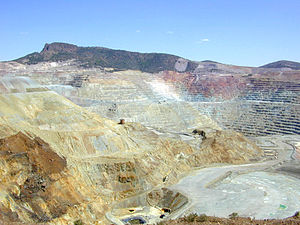Mining

Mining is the extraction of valuable minerals or other geological materials from the earth, usually (but not always) from an ore body, vein, or (coal) seam. Materials commonly recovered by mining include bauxite, coal, copper, diamonds, iron, gold, lead, manganese, magnesium, nickel, phosphate, platinum, salt, silver, tin, titanium, uranium, and zinc. Other highly useful materials that are mined include clay, sand, cinder, gravel, granite, and limestone. Any material that cannot be grown from agricultural processes must be mined. Mining in a wider sense can also include extraction of oil and gas.
History
The oldest known mine in the archaeological record is the "Lion Cave" in Swaziland. At this site, which has a radiocarbon age of 43,000 years, paleolithic humans mined for the iron-containing mineral hematite, which they presumably ground to produce the red pigment ochre.
Sites of a similar age where Neandertals may have mined flint for weapons and tools have been found in Hungary.
Another early mining operation was the turquoise mine operated by the ancient Egyptians at Wady Maghareh on the Sinai Peninsula. Turquoise was also mined in pre-Columbian America in the Cerillos Mining District in New Mexico, where a mass of rock 200 feet (60 m) in depth and 300 feet (90 m) in width was removed with stone tools; the mine dump covers 20 acres (81,000 m²).
Mining techniques
Mining techniques can be divided into two basic excavation types:
1. open-cast or open-pit mining
2. tunneling by shafts into the earth.
Extractive Metallurgy
The science of extractive metallurgy is the study of beneficiation and extraction of valuable metals and minerals from their ores. Although extractive metallurgy is all encompassing, mineral processing or mineral dressing is often the term used for the study of processing coal, industrial minerals and precious stones, as these are not metals.
Environmental effects

Mining can have devastating impacts on the environment due to the massive rearrangement of minerals within the earth. The result can be unnatural high concentrations of some chemical elements over a significantly wider area of surface. Combined with the effects of water and the new 'channels' created for water to travel through, collect in, and contact with these chemicals, a situation is created where mass-scale contamination can occur.
Some examples of environmental problems associated with mining operations are:
- Tar Creek, an abandoned mining area in Picher, Oklahoma that is now an Environmental Protection Agency superfund site. Water in the mine has leaked through into local groundwater, contaminating it with metals such as lead and cadmium. [1]
- Scouriotissa, a copper mine in Cyprus that has been abandoned. Contaminated dust blows off this site.
- Berkeley Lake, an abandoned pit mine in Butte, Montana that has filled with water which is now acidic and poisonous.
Although such issues have been associated with some mining operations in the past, modern mining practices have improved significantly and are subject to close environmental scrutiny. Problems remain especially in countries with lax environmental regulations or enforcement.
See also
References
- References
- Tom Morrison. 1992. Hardrock Gold: A Miner's Tale (ISBN 0806124423)
- Geobacter Project: Gold mines may owe their origins to bacteria (in PDF format)
